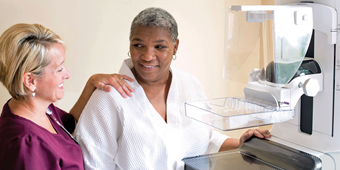Know the Basics About Ovarian Cancer

Answer a few questions and we'll provide you with a list of primary care providers that best fit your needs.
Although a woman’s risk of getting ovarian cancer during her lifetime is 1 in 75, when it occurs, ovarian cancer can be serious. A little knowledge can go a long way to protect your good health.
A woman has two ovaries — one on each side of her uterus. These reproductive glands produce eggs (ova) for reproduction and are also the main source of the female hormones estrogen and progesterone.
Ovaries are made up of three main kinds of cells. Each cell type can develop into a different type of tumor:
- Epithelial tumor: Starts from cells on the outer surface of the ovary. Most ovarian tumors are epithelial cell tumors.
- Germ cell tumor: Rare tumor, starts from cells that produce the eggs
- Stromal tumor: Rare tumor, starts from structural tissue cells
Most ovarian tumors are benign (non-cancerous), don’t spread, and usually don’t lead to serious illness. Benign tumors can be treated by surgery to remove part or all of the ovary.
But some tumors are malignant (cancerous). Ovarian cancer can spread (metastasize). In general, the more cancer spreads, the harder it is to treat.
Younger women tend to develop a type of tumor called low malignant potential (also known as borderline epithelial ovarian cancer) more than typical ovarian cancers. These tumors grow slowly and are less life-threatening than most ovarian cancers.
How Many Women Get Ovarian Cancer?
The American Cancer Society estimates that this year in the United States:
- About 22,440 women will receive a new diagnosis of ovarian cancer.
- About 14,080 women will die from ovarian cancer.
Ovarian cancer ranks fifth in cancer deaths among women. About half the women who are diagnosed with ovarian cancer are 63 years or older. It’s more common in white women than African-American women.
Most ovarian tumors are benign (non-cancerous), don’t spread, and usually don’t lead to serious illness.
Signs and Symptoms

Often, ovarian cancer doesn’t cause any symptoms until after it has spread outside the ovary. Even then, symptoms are often vague, similar to signs of other common diseases. These symptoms include:
- Indigestion, heartburn, nausea or gas
- Belly swelling or discomfort
- Feeling full too quickly
- Pelvic pain or cramping
- Backache
- Painful, frequent, or burning during urination with no infection
- Diarrhea or constipation
- Fatigue
- Loss of appetite
- Unintentional weight loss or gain
- Vaginal bleeding or irregular periods
- Pain during intercourse
When these symptoms are truly caused by ovarian cancer, they tend to be persistent and represent a change from normal. Pay attention to your body, and know what is normal for you. If you have these symptoms more than 12 times a month, see your gynecologist.
Answer a few questions and we'll provide you with a list of primary care providers that best fit your needs.
Source: American Cancer Society; Centers for Disease Control




